Design Wise – July 2016

“Light is the first element of design; without it there is no color, form, or texture.” Thomas E. Farin – educator, lighting consultant, entrepreneur
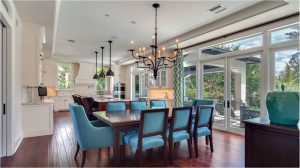 Lighting is such an important part of our lives, and one we take for granted most of the time. For me, I love lighting fixtures. They are like jewellery for the home!
Lighting is such an important part of our lives, and one we take for granted most of the time. For me, I love lighting fixtures. They are like jewellery for the home!
Visually, light fixtures can add style to your home, and in practical terms the lighting you choose can effectively alter the mood or ambience of a room.
We have many lighting choices available that will add that special something to a room, and make it feel complete. Lighting options range from the edgy Industrial style, to sleek Modern and Contemporary styles, and from Rustic fixtures to the latest On-Trend designs.

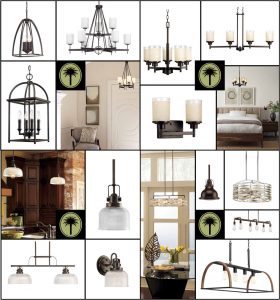 But it is not just about style. Seldom are designers called in to help make a lighting plan for a new home here. That can result in not enough or bad lighting in some areas and too much in others, which translates into wasted energy – and higher ICE bills. High ceilings and dark wood can create their own lighting challenges, but sometimes just knowing what not to do can help make the lighting in your home look, and work perfectly.
But it is not just about style. Seldom are designers called in to help make a lighting plan for a new home here. That can result in not enough or bad lighting in some areas and too much in others, which translates into wasted energy – and higher ICE bills. High ceilings and dark wood can create their own lighting challenges, but sometimes just knowing what not to do can help make the lighting in your home look, and work perfectly.
Here are some common mistakes.
Mistake 1. Installing recessed pot lights everywhere.
This is one of the most common errors. It looks great in magazines perhaps, but in reality using an inexpensive pot light will allow barely half of the lumen output of the bulb to escape. If your ceiling is vaulted or high, even with a grid of pot lights most of that illumination will be lost before it even reaches the floor, and that can make a room feel a bit like a cave. The farther away your light source, the brighter it has to be to be useful. That’s why the worst imaginable fixtures are recessed cans in a high cathedral ceiling. If you simply must have them, then select powerful, tightly focused spot light bulbs to light the space below.
Mistake 2. Forgetting to use task lights in the kitchen.
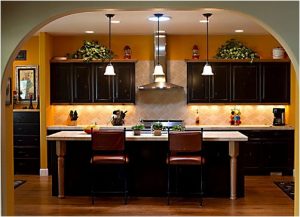 This is a basic necessity. There are many great ways to light the kitchen counter, and one of them is to use fluorescent or LED task lights under the upper cabinets. If your kitchen design lacks upper cabinets over some work surfaces, don’t worry. This is a situation where wall-mounted or pendant fixtures with the right bulb make all the difference. Adding several low voltage halogen fixtures with a narrow flood beam distribution and focusing them on the task area will do the trick. For your kitchen island, use correct height, single pendant lights or a kitchen-island light to illuminate the area. This is an opportunity for a great-looking feature light.
This is a basic necessity. There are many great ways to light the kitchen counter, and one of them is to use fluorescent or LED task lights under the upper cabinets. If your kitchen design lacks upper cabinets over some work surfaces, don’t worry. This is a situation where wall-mounted or pendant fixtures with the right bulb make all the difference. Adding several low voltage halogen fixtures with a narrow flood beam distribution and focusing them on the task area will do the trick. For your kitchen island, use correct height, single pendant lights or a kitchen-island light to illuminate the area. This is an opportunity for a great-looking feature light.
Mistake 3. Using down-lights over the vanity without adding lights on the side.
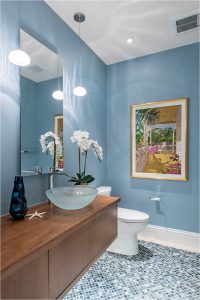 Standing directly under a pot light, without any light at the sides of the face, creates exaggerated and unflattering shadows. In the bathroom, using a down-light over the sink is fine to accent the nice fancy faucet or hand painted bowl you love, but it’s insufficient for tasks like shaving, tweezing, and applying makeup. For this, we need light at the sides of the mirror, and installed at eye level to minimize shadows and provide even distribution. The same lighting effect can be achieved with wall sconces flanking the mirror.
Standing directly under a pot light, without any light at the sides of the face, creates exaggerated and unflattering shadows. In the bathroom, using a down-light over the sink is fine to accent the nice fancy faucet or hand painted bowl you love, but it’s insufficient for tasks like shaving, tweezing, and applying makeup. For this, we need light at the sides of the mirror, and installed at eye level to minimize shadows and provide even distribution. The same lighting effect can be achieved with wall sconces flanking the mirror.
Mistake 4. Not using dimmers.
While we are all trying to finding ways to retrofit lighting with more efficient, longer lived light sources than incandescent, it is still a viable and important part of lighting in a home – provided it is dimmable. By dimming, we decrease energy and heat output and some people think it may also lengthen the life of a bulb. From a designer perspective, a dimmer allows just the right amount of light when you need it, and creates mood.
Mistake 5. Forgetting to incorporate ambient, task and accent lighting.
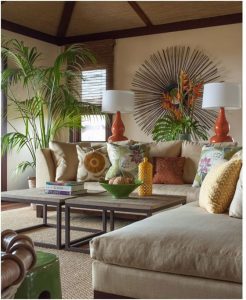 As mentioned in our earlier articles, designers understand that all well-designed spaces incorporate different types of light. Ambient light is general lighting for walking around, conversing, and identifying objects. Task lighting provides higher, more concentrated lighting for tasks such as food preparation, shaving, or reading. Accent light is used to highlight artwork or architectural features, such as a beautiful stone wall, an alcove with collectables or the fabulous glass tiles in the shower. Combining all three types of light gives greater functionality, interest, and likelihood that you will have sufficient lighting.
As mentioned in our earlier articles, designers understand that all well-designed spaces incorporate different types of light. Ambient light is general lighting for walking around, conversing, and identifying objects. Task lighting provides higher, more concentrated lighting for tasks such as food preparation, shaving, or reading. Accent light is used to highlight artwork or architectural features, such as a beautiful stone wall, an alcove with collectables or the fabulous glass tiles in the shower. Combining all three types of light gives greater functionality, interest, and likelihood that you will have sufficient lighting.
Mistake 6. Relying on ceiling fans for light.
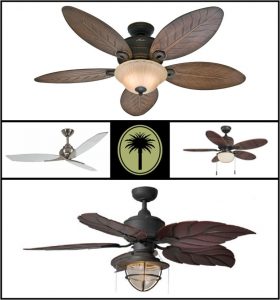 We know that our homes here need good ventilation, but often we struggle between the need for good air movement in a room and a good lighting source. Fans are typically not good for adequately lighting spaces, but there are some beautiful fans out there which you will want to use for cooling and air flow. When you use that great looking fan for light in a room, remember that you will also need some additional lighting from wall sconces or portable lamps.
We know that our homes here need good ventilation, but often we struggle between the need for good air movement in a room and a good lighting source. Fans are typically not good for adequately lighting spaces, but there are some beautiful fans out there which you will want to use for cooling and air flow. When you use that great looking fan for light in a room, remember that you will also need some additional lighting from wall sconces or portable lamps.
Mistake 7. Neglecting to control different types of light separately.
For maximum efficiency and flexibility, each type of light should be controlled separately, and any incandescent, halogen light, or dimmable LED’s should be dimmed. Controlling multiple sources can be achieved by the old school method of multiple light switches – or you can use the new programmable wall box systems. These will give you the right amount of light where and when you need it.
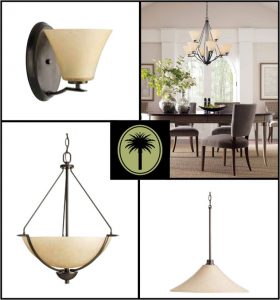 Now we know what not to do, we will be better equipped for making those other important decisions – like what style to choose. This is the fun part!
Now we know what not to do, we will be better equipped for making those other important decisions – like what style to choose. This is the fun part!
The styles of the different light fixtures you choose should all work together. They should have a similar metal finish and be in correct proportion to the space. For the great room, when you are combining the kitchen and living area, select fixtures from the same lighting collection for a cohesive and professional look.
With our humidity and salt infused air, it may be better to stay away from the white metal finishes like chrome, steel and nickel. Bronze, black and antique finishes fare better and require less special cleaning. If you love the look of the white metals then pay a bit more and get the best quality you can. It will pay off in the long run. Look for ‘damp’ or ‘wet location’ ratings, especially in fans.
Wall sconces are very versatile and can be used in almost room. They bounce light off the walls to create a pleasant, soft light. Fixtures with upturned shades will be dust and bug collectors, and will not light your space well unless you have regular height ceilings. They can often be inverted to shine the light down, instead of up.
Pendant lights can be hung individually, in a row, or as a group. Think of more unconventional ways to used these, like over a dining or coffee table. When using pendant task lights in the kitchen for example, don’t hang them too high. The norm is 28″ to 32″ from the counter or table, depending their design and your personal preference. You don’t want to be looking up into the bulb.
And talking about bulbs, remember that low voltage does not mean low energy, so when comparing different types of bulbs compare “wattages”. A 12 volt, 50 watt bulb (excluding transformer) uses the same power as a 240 volt 50 watt bulb. Incandescent and halogen bulbs only convert a small amount of their energy into light – the majority is converted into heat.
Once you have chosen what type of fixtures you need and where they are going, ask yourself if you have achieved a layering of light – have you included task and accent lighting, and considered where you will need the dimmers?
Fixing lighting mistakes after the fact can be an expensive proposition – get it right the first time and enjoy your beautiful new home.
Until next time…
royalpalminteriors@gmail.com
www.royalpalminteriors.com
Like us on Facebook
